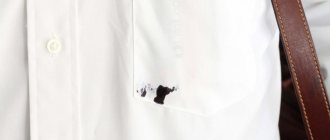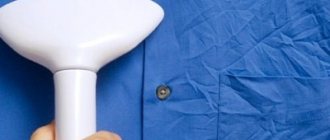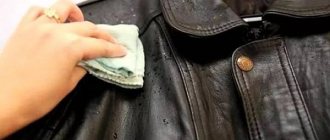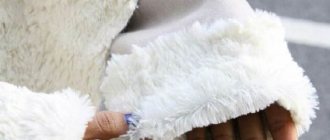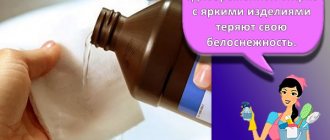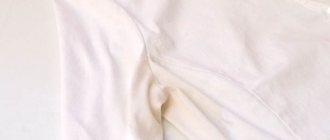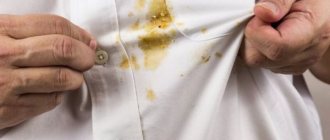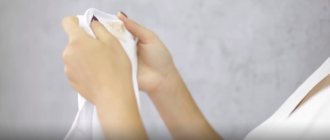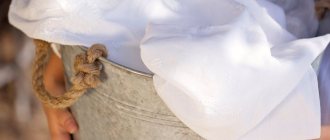The collar is one of the most important parts of a shirt, which is easy to stain and difficult to wash.
Depending on the type of contamination, you can choose a homemade recipe to eliminate the problem or use household chemicals.
In this article we will tell you how to wash the collar of a white or colored men's or women's shirt at home from the yellow stripe on it.
How to wash a white shirt collar at home
Returning the original color to the collar of a white shirt should be approached separately. Often, if you don’t pay enough attention to it, you can find that after washing there are traces of grease or other contaminants.
To avoid this, it is recommended to follow the following washing procedure:
- Try not to wear shirts for more than one day. Despite their visual cleanliness, during wear they absorb traces of dirt and sweat; dirty shirts are much more difficult to wash and have an unpleasant odor.
- Before washing, sort items by shade and texture of fabric. If you do not know how the fabric behaves when washed and whether it fades, wash such items separately. Clothes that are similar in color, if they do not fade, can be washed together. So, by turning off the spin function, at a low temperature you can wash the blue shirt from dirt along with the white one.
- Don't shy away from surface cleaning; rub the shirt with a brush to remove dead skin and external dirt.
- When washing, follow the recommendations on the label.
- Delicate fabrics are best cleaned without using a washing machine.
- Before washing, it is necessary to wash the white collar from visible traces of dirt and soak the clothes briefly.
- When soaking clothes, try to completely immerse them in water, otherwise there is a risk of streaks.
- Pay attention to what exactly you plan to wash your clothes with. You can bleach the collar of a white shirt at home using a variety of means. Today, modern manufacturers offer a large selection of different household laundry products; make sure that they are suitable for the required color and fabric.
Special remedies for stains on the collar
Special products can deal with any stains and stubborn dirt.
Belive Eco stain remover
Add 35 g of stain remover to 1.5-2 liters of water. For best results, use water with a temperature of 40 - 50 degrees.
The oxygen bleach contained in the stain remover is safe for health, environmentally friendly, and does not damage fabrics when washed or soaked.
Washing booster CHISTOWN
Add 35 g of enhancer to 1.5-2 liters of water. Finish the collar. Suitable water temperature is 40 - 50 degrees.
CHISTOWN oxygen wash enhancer safely whitens white items and preserves the colors of colored items with regular use.
How to wash a shirt collar from yellow stripes, how to bleach the collar of a white shirt at home
It is intended for natural and synthetic fabrics. It is a gentle bleach. Release form: liquid and dry.
Expert opinion
Ekaterina Korneva, expert in the field of care, cleanliness and beauty
I will help you understand all the intricacies.
When it was not possible to clean the shirt in time and the dirt has become embedded in the structure of the fabric, it is much more difficult to remove yellow stains on the collar. Despite their visual cleanliness, during wear they absorb traces of dirt and sweat; dirty shirts are much more difficult to wash and have an unpleasant odor. How and how to bleach yellowness from a white shirt at home: folk methods and household chemicals For any questions, please contact me, I will be happy to answer!
How to wash a white shirt collar
- The most common option for removing stains on a shirt is to use stain removers. Professional cleaning products are made taking into account the characteristics of the fabric and perfectly remove traces of any dirt from clothes.
- Laundry soap is also excellent for hand washing and soaking.
- White or bleach will help you wash the collar and cuffs of a white shirt. Unfortunately, they are not suitable for all types of fabric.
- Dirt on the collar can be easily washed off from white clothes using folk remedies. Baking soda, hydrogen peroxide, citric acid, or even dishwashing detergent will help you cope with this task.
Features for white, black, colored items
Once you've sorted your shirts into black, colored and white, you'll need to apply a different washing approach to each batch.
All collars can be washed with universal household chemicals . But the best result is achieved when the preparations intended specifically for them are used for white and black shirts.
Laundry detergents that are intended for white clothes contain bleach, which allows you not only to wash the shirt, but also to maintain its whiteness. Their use on shirts of a different color is prohibited.
Laundry preparations that are designed for black and dark clothes help remove stains and maintain the richness of the dark shade . These products are not used for light-colored products.
If there are few black or white shirts and they are rarely used, you can purchase an economy package of small-volume detergent.
Household chemicals
First, make sure that using your cleaning product will not damage the fabric. To do this, read the washing instructions written on the tag.
Clothes made from delicate fabrics and synthetics should not be cleaned with chlorine-containing or bleaching agents. Oxygen-based whitening is suitable for these purposes. Apply a small amount of this bleach to the yellowed areas of the collar and let stand for 5-10 minutes. Then wash the shirt.
Sweat and excess sebum form the main stains on the collar. Regular shampoo can remove them. Dilute a little shampoo in warm water and apply the solution to the stains.
After 20 minutes, the shirt can be washed in any convenient way.
For particularly difficult stains, use special products such as Antipyatin soap. Apply it to dirty areas and leave for half an hour, then rinse the item thoroughly.
To clean fresh stains, you can use dishwashing detergents. Using a sponge and warm water, whip up foam, apply it to the stain and apply lightly, then rinse under running water.
Preliminary processing
- The sweat-stained areas on the shirt are slightly moistened with warm water and sprinkled with talcum powder, starch or crushed chalk. White items can be treated with soda or salt. Leave everything overnight, and the next day wash with regular laundry soap.
- You can freshen the collar of a shirt using white table vinegar. Dampen a sponge in it and gently wipe off all dirt. Another way is to soak cotton pads in vinegar and apply them to dirty areas of fabric for about 15 minutes. Next, the item is washed.
- Grate a small piece of laundry soap on a fine grater, mix the shavings with hot water to form a thick soap mass. Apply this mixture generously to the stained areas and wrap the shirt tightly in a plastic bag so that moisture is constantly present inside. The item is left in this form overnight. Next, the contaminated areas are washed under warm water and, if necessary, the item is washed by hand or in a washing machine.
- A tablespoon of fine kitchen salt is mixed with 4 tablespoons of warm water, a small amount of liquid soap, possibly dish gel and ammonia (2 - 4 tablespoons). Wipe the contaminated white collar and cuffs with this composition, after which everything is washed off and the item is washed additionally.
- The greasy collar is moistened and rubbed with a paste of water and baking soda. After some time, moisten a soft sponge in table vinegar and additionally wipe the contaminated areas over the soda.
- Industrial powder oxygen bleach will help rid a white shirt of stains. Before using it, carefully read the instructions.
- Hydrogen peroxide will help whiten a stained white shirt. Mix 50 ml of 3% peroxide with any liquid soap. Rub the resulting mixture onto the stains and leave for half an hour. Next, you need to rinse everything thoroughly with clean water and wash the item additionally.
Available means
When for some reason it is impossible to use special household chemicals, you can make do with improvised means:
- Regular lemon juice will help you clean your collar easily. Wipe the dirt with a slice of lemon and after 10-20 minutes, rinse it in running, warm water. This will help get rid of visible dirt.
- Such products as talc, starch, baby powder mixed with table salt will help clean stains. The proportions should be one to one, and the amount should be sufficient to cover the stain completely. A few hours before washing, treat the collar of your shirt with it; immediately before washing, you need to clean the desired areas from the mixture with a brush.
- Using a soft cloth or piece of cotton wool, apply table vinegar to the collar, and after 10-20 minutes, rinse it under running water. With its help you can easily remove greasy stains from a shirt. You can also add a little vinegar to the washing machine drum during washing, it will soften the water.
- A solution of water and hydrogen peroxide in equal proportions is excellent in combating stains on the collar. Using a soft cloth, apply it to the dirt and after 5 minutes rinse with water.
Homemade solutions for washing collars
Products for removing collar stains can be found in your own kitchen and in your home medicine cabinet.
Lemon juice
How to wash a white shirt collar with lemon juice:
Talc and starch
Baby powder will also work. Can be used not only for light, but also for dark and colored shirts.
How I found my ideal hair growth product
Hello dear! I want to share with you my solution to the sensitive problem of hair loss . The problems are very serious, at least for me. I would never have thought that this misfortune would touch me, especially at the age of 29 (read more...)
How to wash the collar of a man's shirt from sweat and dirt:
Hydrogen peroxide
Peroxide has a bleaching effect, so it is suitable for washing collars on white and light shirts:
Vinegar
Table vinegar can be used for a light shirt:
Ammonia
Old stains on the collar that cannot be washed off can be removed with a mixture of ammonia, water and salt:
Features of removing various contaminants
When removing stains for greater efficiency, you should also take into account the type of specific stain and remove it in the best possible way:
- Products containing acids will help remove grease stains from the collar of a white shirt.
- Bleach will cope with most stains, provided that their use does not damage the fabric.
- Traces of food can be removed with simple washing powder or laundry soap.
If there is particularly heavy soiling, it is necessary to soak the shirt, having previously washed away the stains on it.
Lightening of synthetics
- Citric acid effectively removes rust from flax. Add a spoonful of acid to 250 ml of boiling water and dip the stain into this solution. Then wipe with ammonia.
- Remember, if there is a rust stain on a shirt, you can wash it only after removing the rust. If this is not done, the blouse will turn yellow completely.
- The easiest way to remove grease is with dish gel, baby powder or crushed chalk.
So, a men's shirt should look neat. Use simple and accessible products and keep your clothes clean.
Folk remedies Recipes for masks At home Hair loss in women How to stimulate growth Causes of hair loss Hair loss in men Review of vitamins Helpful tips
Removing old stains
When it was not possible to clean the shirt in time and the dirt has become embedded in the structure of the fabric, it is much more difficult to remove yellow stains on the collar.
We offer several of the simplest and most effective ways to deal with old stains:
- Grate a quarter of a piece of laundry soap and dissolve them in warm water. Treat the stain with soap or toothpaste, then soak the shirt for several hours in the prepared solution. Wash and rinse the item until dirt and soap traces are completely removed.
- This method is only suitable for white shirts made of non-delicate fabric. To do this, prepare a solution containing table salt along with ammonia; ammonia perfectly removes dirt from white things, but it can have a strong effect on the structure of the fabric.
- The required proportion of salt and alcohol is 1 to 4. Wash particularly strong stains with the solution, then rinse the item thoroughly. It is necessary to dry clothes after such washing in the fresh air.
Cleansing in 30 minutes
To clean heavily soiled fabric, it is necessary to use more aggressive components.
Dishwashing gel, shampoo for oily hair, anti-stain soap - these products can remove and break down greasy stains on the collar and cuff of a shirt.
Dishwashing gel
Before washing, apply the gel to the yellow stripe on the collar, rub a little and soak in hot water for 30 minutes. After soaking, wash and rinse. You can use shampoo for oily hair as a cleanser - the effect will be the same.
Brush and soap (laundry and other)
Grate half a bar of soap on a coarse grater. Dissolve it in hot water and soak your shirt in the solution. When using liquid laundry soap, no preliminary dissolution is required. For particularly difficult stains, apply a concentrated solution of soap and gently, in a circular motion, rub it with a brush on the shirt.
How to remove makeup stains on a collar
Baking soda and lemon juice will help remove traces of makeup from cuffs and collars. Cosmetics, especially high-quality ones, are strongly absorbed into the fabric. First, wash off such stains with laundry soap, then mix baking soda and lemon juice until it becomes a thick porridge.
Rub the resulting mixture into the stain until traces of cosmetics “float”; when the stain begins to spread, shake off the old mixture and apply a new one. Repeat the process until the item is completely clean.
After which you need to do normal washing.
Turpentine will help dissolve even the most stubborn makeup. Apply a little turpentine to a rag and work the stain on the back of the garment until it begins to spread. Use a dry napkin to blot the stain from the front side, transferring some of the cosmetics onto it, and change the napkin as it gets dirty.
Before washing white items, get rid of stains, otherwise there is a risk that traces of cosmetics will “transfer” to other items.
Helpful information
When bleaching or regular washing, white shirts should not be combined with items of a different color. Even if they do not shed, the color may change, especially in high temperature water.
The whiteness of the shirt may be lost due to improper drying. Avoid direct exposure to sunlight. This is fraught with fading and fading of the fabric.
You need to wash with high-quality powder or gel. To preserve color, choose a product specifically for white items. Often in such powder you can find blue or dark blue granules. Such dyes play the role of my grandmother’s method - using blue to give whiteness.
Important! If you use powder with blue granules, then for hand washing, first dissolve it in water, only then load the laundry. The product is added to the machine in a special compartment, and not directly into the drum.
Many undeservedly ignore the old proven method - starching things. This treatment gives them rigidity, protects them from dirt, and reduces creasing. Starch forms a polymer film on the surface of the fabric, which, when soaked, is easily separated along with the bulk of the contaminants.
For light fabrics, add 2 tsp per 1 liter of water. starch, for the rest 3 tsp. The collar and decorative elements can be shaped by tripling the dosage of the product. Starch is dissolved in water at room temperature, boiling water is added until it reaches a paste consistency, and filtered. The items are dipped into the resulting solution for 5 minutes and ironed without waiting for complete drying. Steam cannot be used.
Important! Only natural fabrics can be starched. Iron the item after treatment without steam, otherwise the effect will disappear.
How to maintain the look of a collar
A few general recommendations on how to keep your collar and shirt looking neat:
- Remember that shirts are worn for no more than one day.
- Before washing your shirt in the machine, fasten all zippers and buttons.
- Always make sure to properly wash and iron your shirt according to the manufacturer's recommendations.
- Ironing is safer on the reverse side.
- When washing, add a little vinegar or water softener.
- LG washing machine UE error what does it mean
- How to dry clothes in an apartment without a balcony
Features of bleaching depending on the type of fabric
When washing, be sure to consider the type of material the shirt is made from. But in any case, a white jacket cannot be placed in the drum together with colored or woolen items.
Cotton
Cotton is a natural hypoallergenic fabric that is resistant to high temperatures and is easy to wash. It can be washed in boiling water and soaked in bleach. But this cannot be done all the time, since such aggressive action causes the fibers to become thinner.
Advice: The better the threads in the fabric are twisted (the fabric is very smooth to the touch), the more difficult it is for dirt to penetrate deep into the fibers and the easier the product will be to wash. Cotton shirts, turtlenecks and blouses that seem to be furry and therefore very soft are more difficult to wash.
Linen
Linen is a durable and natural material that allows air to pass through well and reflects the sun's rays. This fabric is very durable, but it is better not to expose it to chemical bleaches, because they destroy the flax fibers and the shirt loses its attractive appearance. Pay attention to the label; most likely, it will indicate that the use of chlorine-containing products is prohibited.
Silk
Silk can be both natural and artificial, but regardless of the type, this fabric is capricious, requires careful care and is damaged by most bleaches. It cannot be washed in hot water, the optimal temperature is from 20 to 35 degrees, so before washing silk, be sure to check the information on the label.
Synthetics
Synthetic and artificial fabrics are inexpensive, strong, durable and quick-drying, but bleach and boiling water destroy the material. Therefore, polyester of all weaves (from chiffon to fleece), nylon, viscose, polyamide, etc. wash by hand or in an automatic machine, setting the delicate mode and temperature no higher than 40 degrees, and also reducing the cycle time to 30-60 minutes.
Some tips
To effectively clean a white collar of dirt, it must be soaked in warm water for a while and treated with a bleach. Before choosing a method for cleaning and bleaching a white collar, you should determine the material from which it is made. This information, as well as the temperature at which the product can be washed, can be found on the label.
If it is not there, you should assume that the item is synthetic or made of delicate fabric. In other words, choose non-aggressive detergents for washing.
Before soaking and processing the product, it is necessary to clean the dirty but still dry collar with a brush in order to get rid of keratinized skin flakes, which, as a result of friction with the fabric, transfer to the material and cling to its fibers. As a result, they begin to collect dust and sweat, resulting in gray and black streaks.
White shirts should be washed after each wear. Stains should be removed immediately after they appear: it is much easier and simpler than removing old stubborn stains from fabric. It should be remembered that after frequent washing, pills may appear on the fabric. Therefore, it is better to give preference to delicate detergents and low temperature conditions.
The best commercial bleaches
Store-bought products can wash a white shirt efficiently.
There are different types of bleaches:
| Type of bleach | Action | Best representatives |
| Chlorine-containing | Disinfects well and is effective at any temperature. Bleaching is provided by chlorine in the composition | Whiteness, Ace |
| Oxygen | Contains soda and hydrogen peroxide, which releases active oxygen | Vanish Oxi Action, BOS, Persol, Oxygen, Pure |
| Optic | The smallest particles remain in the fabric, reflecting light rays and creating the effect of whiteness. Typically, optical brighteners are included in oxygen | Vanish Gold, Dr. Beckmann, Heitmann |
Important! Chlorine bleaches are only suitable for cotton and linen. Such products are aggressive and accelerate fabric wear.
